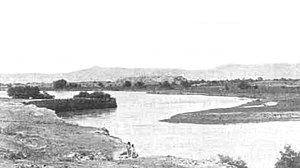
Back পুষ্কলাবতী Bengali/Bangla Pushkalavati Catalan Puškalávatí Czech Pushkalavati German पुष्कलावती Hindi Pushkalavati Italian पुशकलवती Marathi پشکلاوتی PNB புஷ்கலாவதி Tamil پشکلاوتی Urdu
پشکلاوتي | |
Top : The remains of the original mound, Bala Hisar Bottom: Swat river and Bala Hisar mound just beyond (center of the photograph). | |
| Alternative name | Pushkalavati |
|---|---|
| Location | Outskirts of Charsadda, Khyber Pakhtunkhwa, Pakistan |
| Coordinates | 34°10′05″N 71°44′10″E / 34.168°N 71.736°E |
| Type | Ancient capital city |
| History | |
| Founded | c. 1400 BCE |
| Periods | Gandhara |
| Site notes | |
| Excavation dates | 1902 |
| Archaeologists | Sir John Marshall Sir Mortimer Wheeler |
| Management | https://archive.org/details/in.ernet.dli.2015.533479/page/n11/mode/1up "Pushkalavati: The Lotus City"], Archaeological Guide Series No. 1, Peshawar Univ |
Pushkalavati,[a] was the capital of the ancient region of Gāndhāra, situated in present day's Pakistan.[1] Its ruins are located on the outskirts of the modern city of Charsadda, in Charsadda District, in the Khyber Pakhtunkhwa, 35-42 kilometres northeast of Peshawar,[2] at the banks of Jindi River,[3] near the junction of Swat River with Kabul River. The earliest archaeological remains in Bala Hisar mound are from 1400 to 800 BCE.[4][5] Pushkalavati (in Bala Hisar mound) may have been incorporated as an Achaemenid regional settlement around 520 BCE,[6] and it remained an important city (in Shaikhan Dheri mound) through to the beginning of 3rd century CE.[7]
The ruins of Pushkalavati consist of two sites, separated by the small Shambor river.[8] To the south is Bala Hisar, which consists of two separate mounds, one eastern and one western.[9] To the north is Shaikhan Dheri, wedged between the Shambor and Jindi rivers.[10]
Cite error: There are <ref group=lower-alpha> tags or {{efn}} templates on this page, but the references will not show without a {{reflist|group=lower-alpha}} template or {{notelist}} template (see the help page).
- ^ Sagar, Krishna Chandra (1992). Foreign Influence on Ancient India. Northern Book Centre. ISBN 9788172110284.
- ^ Peshawar to Charsadda
- ^ Jindi River
- ^ Petrie, Cameron, 2013. "Charsadda", in D.K. Chakrabarti and M. Lal (eds.), History of Ancient India III: The Texts, Political History and Administration til c. 200 BC, Vivekananda International Foundation, Aryan Books International, Delhi, p. 515: "The recent absolute dating of early deposits [of 'Soapy red'/red burnished ware] at the Bala Hisar (GrA-8358: 1420-1160 BC; Peshawar-Bradford Period II-Coningham and Batt 2007: 93-98; also Young 2003: 39) has, however, provided clear confirmation of previous suppositions that this ware and the corresponding early levels at the Bala Hisar date from around 1400 BC onwards into the early 1st millennium BC, c. 800 BC."
- ^ Coningham, R.A.E. and C. Batt, 2007. "Dating the Sequence", in R.A.E. Coningham and I. Ali (eds.), Charsadda: The British-Pakistani Excavations at the Bala Hisar, Society for South Asian Studies Monograph No. 5, BAR International Series 1709, Archaeopress, Oxford, pp. 93-98
- ^ Petrie, Cameron A., (2013). "South Asia", in: The Oxford Handbook of Cities in World History, Oxford University Press, p. 99: "[T]he regions at the western-most edge of South Asia were incorporated into the Achaemenid empire (c. 520 BCE) [...] The limited excavations have revealed no evidence for the establishment of Persian administrative buildings or palaces in cities like Charsadda [...] but there appears to be some evidence of the emulation of Achaemenid drinking vessels, which may indicate that local elites adopted some symbols of authority and certain culinary practices."
- ^ Dani, A. H., (1965-66). "Shaikhan Dheri Excavation 1963 & 1964 Seasons (In Search of the Second City of Pushkalavati), in: Ancient Pakistan II, p. 24: "Thus the end of the [Shaikhan Dheri] city came towards the close of the second century A. D. or in the middle of the 3rd century A. D."
- ^ Dani, Ahmad Hasan, 1963. Pushkalavati: The Lotus City, Archaeological Guide Series No. 1, Peshawar University, Peshawar, pp. 4-5.
- ^ Dani, Ahmad Hasan, 1963. Pushkalavati: The Lotus City, Archaeological Guide Series No. 1, Peshawar University, Peshawar, pp. 4-5: "First […] is the Bala-Hisar mound, actually there are two mounds, approachable by a pathway from the main Peshawar road just where it makes a sharp bend towards the river Jinde (a branch of Swat river) immediately before the bridge that acts as a gateway to the modern town of Charsadda […] Sir Mortimer traces the material of the western mound to the iron age and dates its beginning to about the 6th century B.C. […] According to him this was the city invested by Alexander’s generals. In the 3rd-2nd century B.C. the eastern mound, which was separated from the western at this time by a river (now dried up), assumed importance, but not for long."
- ^ Dani, Ahmad Hasan, 1963. Pushkalavati: The Lotus City, Archaeological Guide Series No. 1, Peshawar University, Peshawar, p. 5: "[I]t is suggested that the main centre of activity had shifted by or before the 1st century B.C. to another site at Shaikhan Dheri, north of the river Sambor, now a marshy channel, which separates Bala-Hisar from Shaikhan Dheri […] this mound is caught up between two rivers, Sambor on the south and Jinde on the east. The consequent changes in these rivers did not allow the city to flourish long."




